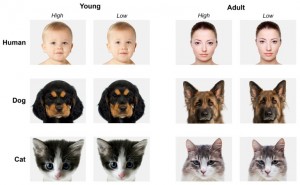
Walking to class the other day, I was taken aback by the cuteness of the puppies in training that prance around campus. Why are puppies so cute? It’s not the most mature question to analyze, but surprisingly the reasoning behind my playful curiosity is relatively scientific. According to this blog, kinderschema, or baby schema, is the scientific theory to explain cuteness. This hypothesis encapsulates all of the physical features that humans consider “cute” in babies and animals, which range from large eyes to a soft body. However, the blog recognizes that kinderschema was originally developed somewhat anecdotally. Thus, scientists are starting to make up for the lack of psychological explanation behind this theory. In this study, the characteristics of baby schema are tested through a visual manipulation experiment. Groups of 3-6 year old children were randomly allocated either a control picture or a “cuteness enhanced” picture of a baby, dog, or cat. Then, they were asked to rate the cuteness. Their reaction to the picture was also observed, specifically tracking their attention towards the already established kinderschema qualities. To eliminate age being a potential bias, adults were also put through the same experimentation. As a result, the concepts of baby schema were confirmed, and predicted to be a potential part of early childhood development.
In addition, the study discovered that features of baby schema triggered feelings of “infantile stimuli,” or other feelings you get when you see something cute. For instance, this article shares that baby schema features are linked with the human desire to be caretakers. Oxford researchers are currently experimenting how parental brains react to infants, specifically in studying the was cuteness stimulates various natural senses. In addition to the urge to care take, this article delves deeper into the scientific reaction to the features of baby schema. Dopamine, or the neurochemical associated with pleasure, is released in the brain. This chemical reaction takes place in the mesocorticolimbic area of the brain, which is centrally located. Therefore, when our brains recognize cuteness, we experience subsequent happiness.

Picture found in above article
Overall, cuteness can be scientifically attributed to various physical features known as kinderschema. While there has been a limited amount of experimentation to back up this theory, it is very well acclaimed and almost able to be proven by self experimentation. See what I mean by looking at this! I would love to see more controlled experiments on this question, as it applies to a greater purpose than simply the feelings of seeing a puppy on the street. For instance, what is the significance that Frozen, ranked as the highest grossing animated film of all time, contains characters with larger eyes than traditional Disney characters? This New York Times article brings up the brilliant point that proving baby schema would not only help us to understand our own perception, but play a vital role in fields like design, entertainment, and advertising.




I actually participated in a study like this recently so I found this very interesting. For my psychology class I am required to participate in 6 hours of research study and I happened to sign up for one just like this! During the study I was asked to observe different proportions on different peoples faces to show how we viewed different people. Im not sure if that study I was in has been concluded but I did some research to find out more information. I found this study that says people are attracted to symmetry. There is even a formula for facial beauty and I also find it interesting and funny that they found that men look more for symmetry then women do. Hmmmm. If you want to read more about what makes someone attractive I recommend reading the article linked above, I found it very interesting.
Hi, Hannah Marni Stern. You write a very interesting blog that related to cuteness. As we all know, baby can be described as cute because their physical features aren’t grow completely like adult and soft bodies have a good touch sense. You give me several pictures to compare the differences between puppies and baby. To be honest, I don’t how baby’s cuteness can make others know their own view and perception previously, but when I finish reading your blog, I get know that not only cuteness can reflect perception, but also it’s inevitable in entertainment field. Impressive blog. Here is a video for you https://www.youtube.com/watch?v=DdTr15UZoMY
Great job Hannah! I enjoyed this blog very much. I was drawn to this blog, not only by the picture of the adorable puppies, but by the title. I’ve always wondered how we determine what’s cute and what’s ugly. However, after reading you’re blog, I learned that it’s from dopamine being released in the brain. Which ends up in us feeling happy. I love how you talked about “Frozen” and how the media is now working off on what humans find cute. Now more Disney characters have big colorful eyes, rather than tiny and narrow. As shown in this article, http://www.theatlantic.com/health/archive/2013/11/the-psychology-of-giant-princess-eyes/281209/, new Disney princess like Rapunzel and Elsa have bigger eyes than Cinderella and Snow White. This is due to us, humans, finding people with bigger eyes to be more cute and attractive.